The flora of the volcanic complex is essentially Mediterranean, due to its proximity to the sea and the low altitudes that reach their maximum in 1281 meters above sea level of the Grand Cone of Vesuvius. From the copious literature more than 1000 species are ascertained in time, considering also the extinct ones and those whose colonization is recent. Today, many of the species present in the past have not been found anymore, due to both the variations in land use and the accentuation of anthropization, especially in recent decades. Recent studies have made it possible to ascertain that the flora present in the Vesuvian territory counts – including spontaneous alien species – more than 800 entities, of which only about 2% are endemic, such as the rare Silene giraldii, present not only on Vesuvius, but also on Capri and Ischia.
Orchids represent one of the richest families of plant species in the world: there are, in fact, more than 25,000 different types, spread throughout the earth’s surface, with the exception of regions with very cold or desert climates. The flowers, besides being particularly elegant, delicate and colourful, are extremely evolved to adapt to pollination by insects (entomophilous pollination). In the area of the Vesuvius National Park there are 21 species of orchids, which color the undergrowth in spring with delicate hues, from white to pink, from lilac to fuchsia. Their flowering is short and you need to be patient and careful to catch the moment when you can admire beautiful blooms. Only one species, Spiranthes spiralis, blooms in autumn.

In recent decades, the profound changes of human origin have favoured the settlement of many species foreign to the Vesuvian flora. The introduction of exotic plants has often been justified by the need to accelerate the recolonization of bare soils and to stabilize slopes. These species have often had an impact on native plant groups, especially when some of the introduced species have shown such competitive capacities as to alter the ecological balance of the environment in which they have been planted. Among the alien species are the Genista aetnensis, endemic to Etna and eastern Sardinia and imported to Vesuvius in 1906 for reforestation, now largely spontaneous, and the Robinia pseudoacacia, native to North America, which has also constituted monospecific formations, especially on the Somma slopes.

The birch (Betula pendula) is a Euro-Siberian species that extends its range from the Arctic Circle to the mountainous areas of the Mediterranean region. It is present on Mount Somma with small nuclei; they are considered a testimony of mesophilic relict woods that covered the slopes of the volcano in past eras, characterized by climates more humid and cooler than the current ones; but it could also be the expression of particular microclimatic conditions of a continental type that have developed in restricted areas of the volcanic complex. As well as from a phytogeographical point of view, this plant is also highly interesting because it is rare and at risk of extinction at regional level.








